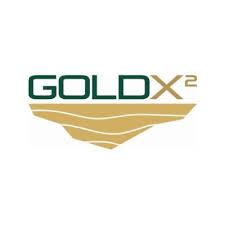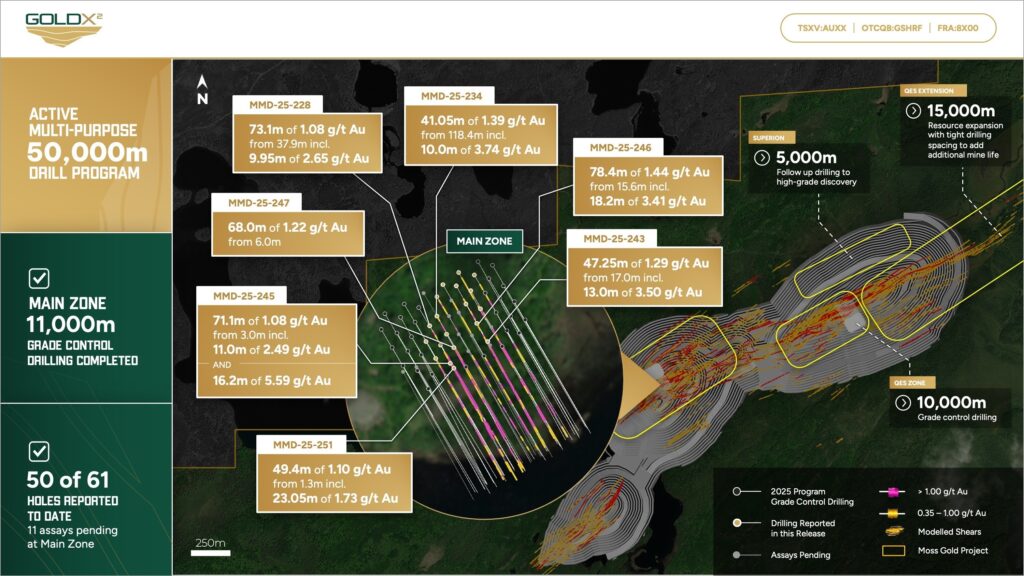
Grade Control Drilling at Moss Main Zone Defines Higher Grade Corridors Intersecting 78.4m of 1.44 g/t Au from 15.6m

Gold X2 Mining Inc. (TSXV: AUXX) (OTCQB: GSHRF) (FWB: 8X00), is pleased to announce the third batch of assay results from its ongoing grade control drill program, with nineteen shallow holes targeting the marginal to core shears within the Main Zone at the Moss Gold Project in Northwest Ontario, Canada.
Michael Henrichsen, CEO of GoldX2 commented, “We are pleased with the latest batch of results that show long continuous broad intervals of gold mineralization that continue to align with our geological model. In addition, higher grade internal intervals within these broad intercepts line up well between drill holes demonstrating continuity and furthers our understanding of the geometry of high grade with the deposit with higher density drilling. This information is crucial as we look to define higher grade zones that could positively impact the economic performance of the deposit moving forward.”
Highlights
- Overall results from the nineteen holes in this news release continue to strengthen confidence in the continuity of wide, near-surface, high-grade shear corridors defining the center of the Moss Main Zone. Select drill intercepts include:
- 73.1m of 1.08 g/t Au from 37.9m in MMD-25-228, including
- 9.95m of 2.65 g/t Au from 76.1m, and
- 2.0m of 11.59 g/t Au from 105.0m
- 41.05m of 1.39 g/t Au from 118.4m in MMD-25-234, including
- 10.0m of 3.74 g/t Au from 147.0m
- 47.25m of 1.29 g/t Au from 17.0m in MMD-25-243, including
- 13.0m of 3.5 g/t Au from 22.0m
- 71.1m of 1.08 g/t Au from 3.0m in MMD-25-245, including
- 11.0m of 2.49 g/t Au from 19.0m, and
- 16.2m of 5.59 g/t Au from 80.0m
- 78.4m of 1.44 g/t Au from 15.6m in MMD-25-246, including
- 18.2m of 3.41 g/t Au from 74.8m
- 68.0m of 1.22 g/t Au from 6.0m in MMD-25-247, including
- 15.05m of 2.36 g/t Au from 32.95m, and
- 4.0m of 5.48 g/t Au from 69.0m
- 49.4m of 1.10 g/t Au from 1.3m in MMD-25-251, including
- 23.05m of 1.73 g/t Au from 2.95m
- 73.1m of 1.08 g/t Au from 37.9m in MMD-25-228, including
- In addition to the high-grade mineralized intercepts reported within the mineralized near-surface, high-grade shear corridors, the Moss Main grade control program outlined the following additional high-grade intercepts:
- 5.1m of 5.6 g/t Au from 152.0m in MMD-25-232
- 4.0m of 8.32 g/t Au from 178.0m in MMD-25-233
- 7.0m of 5.07 g/t Au from 125.0m in MMD-25-249
Technical Overview
The results of the current grade control drill program are illustrated in the following figures and tables. Figure 1 shows the location map of the drill holes reported in this release, relative to the Moss Main grade control drill program. Figure 2 provides a cross-section of drill holes MMD-25-226, MMD-25-228, MMD-25-242, MMD-25-245, and MMD-25-251 representing the third easternmost section of the pattern. The results are summarized in Tables 1-1, which include significant intercepts (Table 1) and drill hole locations (Table 2).

Figure 1: Illustrates the Moss Main grade control drill program. Drill holes being reported are highlighted in gold.

Figure 2: Shows a type section with reported intersections relative to the block model. Note: the block model has factored volumes that cannot be illustrated on section.
In preparation for the infill drilling campaign, two grade control drilling programs were designed, one at each the Main and QES zones. The Main Zone pattern covers an area that is 100 meters along strike, 80 meters across strike and 170-190 meters deep. Drill holes are spaced in a 12.5-meter diamond-shaped pattern. All hole at the Main zone pattern have been completed with drilling activities shifted to the QES zone pattern.
These programs aim to investigate the short distance behaviour of gold mineralization, informing the determination of optimal drill spacing to upgrade Inferred Mineral Resources to Indicated Mineral Resources in preparation for the upcoming infill program. Additionally, the remaining half core will supply the required volume of sample for the upcoming feasibility level metallurgical studies. Finally, the tight spaced drilling provides mining-level precision that will derisk the Mineral Resource Estimate.
The assay data from the thirteen holes reported herein, and the previous twenty-one holes (press release dated September 10th, 2025, and October 29th, 2025), have outlined two main parallel shears consistently containing greater than 2.5 g/t gold mineralization, one of which runs along historical exploration drift. Intercepts include 2.0m of 11.59 g/t Au from 105.0m in MMD-25-228, 5.1m of 5.6 g/t Au from 152.0.0m in MMD-25-232, 4.0m of 8.32 g/t Au from 178m in MMD-25-233, 10.0m of 3.74 g/t Au from 147.0m in MMD-25-234, 7m of 3.25 g/t Au from 187.0m in MMD-25-241, 13.0m of 3.5 g/t Au from 22.0m in MMD-25-243, 15.2m of 5.93 g/t Au from 81.0m in MMD-25-245, 18.2m of 3.41 g/t Au from 74.8m in MMD-25-246, 4.0m of 5.48 g/t Au from 69.0m in MMD-25-247, 6.0m of 4.6 g/t Au from 148.0m in MMD-25-248, 7.0m of 5.07 g/t Au from 125.0m in MMD-25-249, 5.3m of 3.84 g/t Au from 98.0m in MMD-25-250, and 7.4m of 3.74 g/t Au from 82.6m in MMD-25-251.
Understanding the highest-grade portion of the mineralized shear system, which will drive any potential mining sequencing, will help ensure the most profitable mine plan can be developed in future technical studies. The knowledge gained from the grade control patterns will assist in properly defining these high-grade zones elsewhere in the mineral resource and will be factored into the development of the upcoming infill program.
The logging of the additional holes has been in line with the geology predicted from the earlier drilling. The mineralized intersections continue to be defined in moderately to strongly sheared diorites and granodiorites with either sericite-chlorite or sericite-silica-hematite altered and pyrite±chalcopyrite mineralization. The consistency and predictability of the geology and assay results will support the modelling of a robust short-range geological model to support future exploration targeting and MRE estimations.

Figure 3: Hole MMD-25-245: Section of sheared and sericite-chlorite-silica altered mineralized diorite yielding an intercept of 11.6 g/t of 5.59 g/t Au (9.14 g/t Au uncut) from 80.0m, including section containing denser mineralized quartz-carbonate veining yielding an intercept of 2.2m of 26.7g/t Au (52.8 g/t uncut) from 94.0m.
Table 1: Significant intercepts

Table 2: Drill Collars

Analytical and QA/QC Procedures
The HQ diameter drill core has been oriented using ACTIII or equivalent tools and validated in the core shack. All core has been sawed in half cut just off the core orientation line (bottom of hole) with the right half (looking down hole) of the core bagged and sent a third-party analytical laboratory. The left half of the core was returned to core boxes and is stored at Gold X2’s Kashabowie core yard facility.
All samples were sent to ALS Geochemistry in Thunder Bay for preparation and analysis was performed in the ALS Vancouver analytical facility. ALS is accredited by the Standards Council of Canada (SCC) for the Accreditation of Mineral Analysis Testing Laboratories and CAN-P-4E ISO/IEC 17025. Samples were analysed for gold via fire assay with an AA finish (“Au-AA23”) and 48 pathfinder elements via ICP-MS after four-acid digestion (“ME-MS61”). Samples that assayed over 10 ppm Au were re-run via fire assay with a gravimetric finish (“Au-GRA21”).
In addition to ALS quality assurance / quality control protocols, Gold X2 has implemented a quality control program for all samples collected through the drilling program. The quality control program was designed by a qualified and independent third party, with a focus on the quality of analytical results for gold. Analytical results are received, imported to our secure on-line database and evaluated to meet our established guidelines to ensure that all sample batches pass industry best practice for analytical quality control. Certified reference materials are considered acceptable if values returned are within three standard deviations of the certified value reported by the manufacture of the material. In addition to the certified reference material, certified blank material is included in the sample stream to monitor contamination during sample preparation. Blank material results are assessed based on the returned gold result being less than ten times the quoted lower detection limit of the analytical method. The results of the on-going analytical quality control program are evaluated and reported to Gold X2 by Orix Geoscience Inc.
Qualified Person
Peter Flindell, PGeo, MAusIMM, MAIG, Vice-President, Exploration, of the Company, and a qualified person under National Instrument 43-101 – Standards of Disclosure for Mineral Projects, has approved the scientific and technical information contained in this news release.
Mr. Flindell has verified the data disclosed. To verify the information related to the winter drill program at the Moss Gold Project, Mr. Flindell has visited the property several times; discussed and reviewed logging, sampling, bulk density, core cutting and sample shipping processes with responsible site staff; discussed and reviewed assay and QA/QC results with responsible personnel; and reviewed supporting documentation, including drill hole location and orientation and significant assay interval calculations. He has also overseen the Company’s health and safety policies in the field to ensure full compliance, and consulted with the Project’s host indigenous communities on the planning and implementation of the drill program, particularly with respect to its impact on the environment and the Company’s remediation protocols.
About Gold X2 Mining
Gold X2 is a growth-oriented gold company focused on delivering long-term shareholder and stakeholder value through the acquisition and advancement of primary gold assets in tier-one jurisdictions. It is led by the ex-global head of structural geology for the world’s largest gold company and backed by one of Canada’s pre-eminent private equity firms. The Company’s current focus is the advanced stage 100% owned Moss Gold Project which is positioned in Ontario, Canada, with direct access from the Trans-Canada Highway, hydroelectric power near site, supportive local communities and skilled workforce. The Company has invested over $75 million of new capital and completed approximately 100,000 meters of drilling on the Moss Gold Project, which, in aggregate, has had over 255,000 meters of drilling. The 2024 updated NI 43-101 mineral resource estimate has expanded to 1.54 million ounces of Indicated gold resources at 1.23 g/t Au, contained within 38.96 million tonnes and 5.20 million ounces of Inferred gold resources at 1.11 g/t Au, contained within 146.24 million tonnes. The MRE only encompasses 3.6 kilometers of the 35+ kilometer mineralized trend, remains open at depth and along strike and is one of the few remaining major Canadian gold deposits positioned for development in this cycle. Please see NI 43-101 technical report titled: “Technical Report and Updated Mineral Resource Estimate for the Moss Gold Project, Ontario, Canada,” dated March 20, 2024 with an effective date of January 31, 2024 available under the Company’s SEDAR+ profile at www.sedarplus.ca.
MORE or "UNCATEGORIZED"
Troilus Closes $172.5 Million Bought Deal Public Offering Including the Full Exercise of Over-Allotment Option
Troilus Gold Corp. (TSX: TLG) (OTCQX: CHXMF) (FSE: CM5R) is pleas... READ MORE
Emerita Intersects 9.6 Meters Grading 2.7% Copper, 1.85 g/t Gold and 6.9 Meters Grading 1.4% Copper, 1.85 g/t Gold at El Cura Deposit
Emerita Resources Corp. (TSX-V: EMO) (OTCQB: EMOTF) (FSE: LLJA) i... READ MORE
Mundoro Closes Previously Announced Private Placement
Mundoro Capital Inc. (TSX-V: MUN) announces that further to its n... READ MORE
Argenta Silver Corp. Announces Discovery of New Exploration Target and Commences Summer Drill Program at El Quevar Project
Argenta Silver Corp. (TSX-V: AGAG) (OTCQB: AGAGF) (FSE: T1K) is p... READ MORE












